Optical cloaking with metamaterials
opticallimitingmaterials光学材料限制48

Sn
Sn
S
E S1
S
E S1
Tn
T kisc
T1
G
kSG
G kSG
kTG
G
G
Three-level energy diagram
Four-level energy diagram
Reverse Saturable Absorption (RSA)
• The excited state cross section is larger than the ground state cross section.
• Sequential TPA, ES > G. • ES > the pulse duration. • Wide range of incident intensities.
• Low threshold.
• Large non linear absorption over a broad spectral bandwidth.
• Output s. input fluence
Input fluence
Transmission
• Transmission vs. input energy
Input energy
Porphyrins and Phthalocyanines
Porphyrins and Phthalocyanines
• Conclusion
Introduction
• Lasers are used in: CD players, scanners, laser pointers, spectroscopic studies, optical sensors, astronomy, military, etc.
声学超构材料术语

声学超构材料术语1范围本文件规定了包括声子晶体、声超材料等人工微结构的声学超构材料等相关术语的定义。
本文件适用于声学超构材料及其相关领域的活动。
2规范性引用文件下列文件对于本文件的应用是必不可少的。
凡是注日期的引用文件,仅所注日期的版本适用于本文件。
凡是不注日期的引用文件,其最新版本(包括所有的修改单)适用于本文件。
GB/T32005-2015电磁超材料术语GB/T3947-1996声学名词术语3基础定义3.1超构材料metamaterials一种特种复合材料或结构,通过对材料关键物理尺度上进行一定序构设计,使其获得常规材料所不具备的超常物理性能。
3.2声学超构材料acoustic metamaterials具备超常声学特性的一类超构材料3.3声子晶体phononic crystal由两种以上具有不同弹性参数的材料按一定空间序构周期排列的复合人工介质形成的一种声学超构材料。
4分类4.1固体弹性波超构材料solid elastic wave metamaterials用于调控固体中弹性波的声学超构材料。
4.2水声超构材料underwater acoustic metamaterials用于调控水中声波的声学超构材料。
4.3空气声超构材料用于调控空气中声波的声学超构材料。
4.4次声声学超构材料infrasound metamaterials工作频率在20Hz以下的声学超构材料4.5超声声学超构材料ultrasonic metamaterials工作频率在20kHz以上的声学超构材料4.6可听声超构材料audible sound metamaterials工作频率在20Hz-20kHz范围的声学超构材料4.7局域共振型声学超构材料resonant acoustic metamaterials基于局域共振原理的声学超构材料4.8非局域共振型声学超构材料non-resonant acoustic metamaterials 不基于局域共振原理的声学超构材料4.9线性声学超构材料linear metamaterials具有线性动力学效应的声学超构材料4.10非线性声学超构材料nonlinear metamaterials具有非线性动力学效应的声学超构材料4.11各向同性声学超构材料isotropic acoustic metamaterials具有各向同性的声学特性的声学超构材料4.12各向异性声学超构材料anisotropic acoustical metamaterials具有各向异性的声学特性的声学超构材料4.13复合声学超构材料composite acoustic metamaterials与其他材料复合的声学超构材料4.14可重构声学超构材料reconfigurable acoustic metamaterials宏观或微观结构可重构的声学超构材料4.15可编程声学超构材料programmable acoustic metamaterials利用逻辑基元对声场进行程序化调控的声学超构材料4.16微纳声学超构材料micro-scale acoustic metamaterials微观结构的绝对尺度在微米或纳米级的声学超构材料4.17多物理场耦合型超构材料multi-physical coupled metamaterials 声场与其他物理场相互耦合的声学超构材料4.18吸声超构材料sound absorption metamaterials能够有效控制噪声且尺寸小巧的声学超构材料。
Review用于声波调控的五模式超材料Pentamodemetamaterialsfor
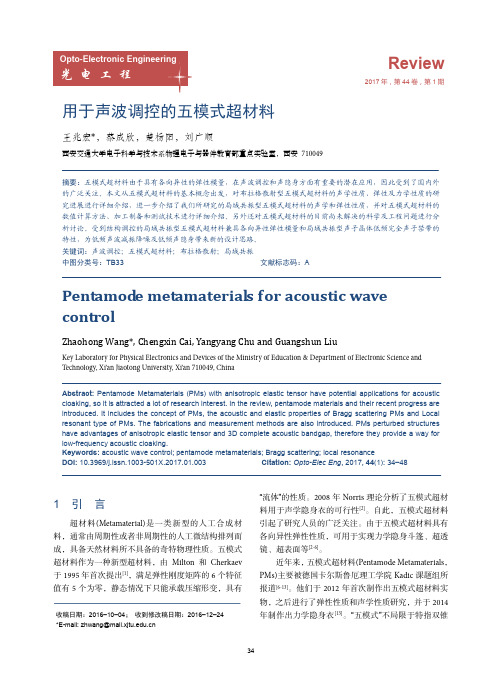
用于声波调控的五模式超材料王兆宏*,蔡成欣,楚杨阳,刘广顺西安交通大学电子科学与技术系物理电子与器件教育部重点实验室,西安 710049摘要:五模式超材料由于具有各向异性的弹性模量,在声波调控和声隐身方面有重要的潜在应用,因此受到了国内外的广泛关注。
本文从五模式超材料的基本概念出发,对布拉格散射型五模式超材料的声学性质、弹性及力学性质的研究进展进行详细介绍,进一步介绍了我们所研究的局域共振型五模式超材料的声学和弹性性质,并对五模式超材料的数值计算方法、加工制备和测试技术进行详细介绍。
另外还对五模式超材料的目前尚未解决的科学及工程问题进行分析讨论。
受到结构调控的局域共振型五模式超材料兼具各向异性弹性模量和局域共振型声子晶体低频完全声子禁带的特性,为低频声波减振降噪及低频声隐身带来新的设计思路。
关键词:声波调控;五模式超材料;布拉格散射;局域共振中图分类号:TB33 文献标志码:APentamode metamaterials for acoustic wave controlZhaohong Wang*, Chengxin Cai, Yangyang Chu and Guangshun LiuKey Laboratory for Physical Electronics and Devices of the Ministry of Education & Department of Electronic Science and Technology, Xi’an Jiaotong University, Xi’an 710049, ChinaAbstract: Pentamode Metamaterials (PMs) with anisotropic elastic tensor have potential applications for acoustic cloaking, so it is attracted a lot of research interest. In the review, pentamode materials and their recent progress are introduced. It includes the concept of PMs, the acoustic and elastic properties of Bragg scattering PMs and Local resonant type of PMs. The fabrications and measurement methods are also introduced. PMs perturbed structures have advantages of anisotropic elastic tensor and 3D complete acoustic bandgap, therefore they provide a way for low-frequency acoustic cloaking.Keywords: acoustic wave control; pentamode metamaterials; Bragg scattering; local resonanceDOI:10.3969/j.issn.1003-501X.2017.01.003 Citation: Opto-Elec Eng, 2017, 44(1): 34‒481 引言超材料(Metamaterial)是一类新型的人工合成材料,通常由周期性或者非周期性的人工微结构排列而成,具备天然材料所不具备的奇特物理性质。
声波超材料种类和功能性描述
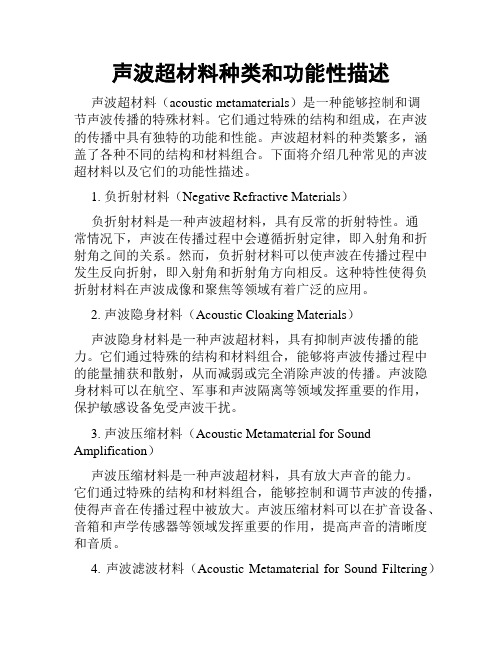
声波超材料种类和功能性描述声波超材料(acoustic metamaterials)是一种能够控制和调节声波传播的特殊材料。
它们通过特殊的结构和组成,在声波的传播中具有独特的功能和性能。
声波超材料的种类繁多,涵盖了各种不同的结构和材料组合。
下面将介绍几种常见的声波超材料以及它们的功能性描述。
1. 负折射材料(Negative Refractive Materials)负折射材料是一种声波超材料,具有反常的折射特性。
通常情况下,声波在传播过程中会遵循折射定律,即入射角和折射角之间的关系。
然而,负折射材料可以使声波在传播过程中发生反向折射,即入射角和折射角方向相反。
这种特性使得负折射材料在声波成像和聚焦等领域有着广泛的应用。
2. 声波隐身材料(Acoustic Cloaking Materials)声波隐身材料是一种声波超材料,具有抑制声波传播的能力。
它们通过特殊的结构和材料组合,能够将声波传播过程中的能量捕获和散射,从而减弱或完全消除声波的传播。
声波隐身材料可以在航空、军事和声波隔离等领域发挥重要的作用,保护敏感设备免受声波干扰。
3. 声波压缩材料(Acoustic Metamaterial for Sound Amplification)声波压缩材料是一种声波超材料,具有放大声音的能力。
它们通过特殊的结构和材料组合,能够控制和调节声波的传播,使得声音在传播过程中被放大。
声波压缩材料可以在扩音设备、音箱和声学传感器等领域发挥重要的作用,提高声音的清晰度和音质。
4. 声波滤波材料(Acoustic Metamaterial for Sound Filtering)声波滤波材料是一种声波超材料,具有过滤和控制声波频率的能力。
它们通过特殊的结构和材料组合,能够选择性地通过或阻塞不同频率的声波,从而实现对声波信号的过滤和调控。
声波滤波材料可以在声学设备、通信系统和噪声控制等领域发挥重要的作用,提供清晰的声音传输和抑制噪声的功能。
负折射率和光学隐形装置

负折射率材料以及隐形装置的研制成功,不仅给 促进了纳米、光学等向光学科的发展,而且给人们 提出了更多的课题。
参考文献:
1. Steven A. Cummer, Bogdan-Ioan Popa, David Schurig, David R. Smith, John Pendry: Full-wave simulations of electromagnetic cloaking structures[J]
被遮蔽物
隐形材质
真空
隐形材料
Vladimir Shalaev等人进行了一组二维的光学隐形实验。上图显示的是683.2 纳米的红光通过一个二维的光学隐形装置的传播情况。控制隐形材质的相关 变量(主要是介电常数和磁导率), Vladimir Shalaev等人使光线光滑的绕 过了障碍物,也就是,使被遮蔽物隐形了。
这就是这种负折射率材质的立体模型
Pendry和D.R. Smith在 他们的论文中指出,如 左图所示,电磁波在负 折射率介质(a)中发生 的折射的确与正常介质 (b)中的不同。 Nhomakorabeaa
b
在负折射 率介质透 镜中,电 磁波也发 生了与在 通常介质 中完全相 反的折射 现象。
但是Pendry等人的模型存在着很大的局限, 光波的频率范围是4.5×1014 Hz~7.3×10 14 Hz,而Pendry & Smith模型的有效范围是 GHz频段,也就是10 9 Hz。这种材料还不能 真正使可见光波发生负折射现象。
advanced optical materials分区
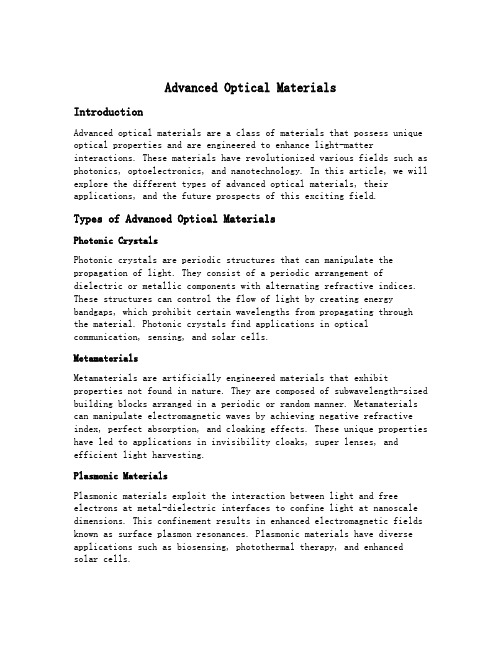
Advanced Optical MaterialsIntroductionAdvanced optical materials are a class of materials that possess unique optical properties and are engineered to enhance light-matter interactions. These materials have revolutionized various fields such as photonics, optoelectronics, and nanotechnology. In this article, we will explore the different types of advanced optical materials, their applications, and the future prospects of this exciting field.Types of Advanced Optical MaterialsPhotonic CrystalsPhotonic crystals are periodic structures that can manipulate the propagation of light. They consist of a periodic arrangement ofdielectric or metallic components with alternating refractive indices. These structures can control the flow of light by creating energy bandgaps, which prohibit certain wavelengths from propagating through the material. Photonic crystals find applications in optical communication, sensing, and solar cells.MetamaterialsMetamaterials are artificially engineered materials that exhibit properties not found in nature. They are composed of subwavelength-sized building blocks arranged in a periodic or random manner. Metamaterials can manipulate electromagnetic waves by achieving negative refractive index, perfect absorption, and cloaking effects. These unique properties have led to applications in invisibility cloaks, super lenses, and efficient light harvesting.Plasmonic MaterialsPlasmonic materials exploit the interaction between light and free electrons at metal-dielectric interfaces to confine light at nanoscale dimensions. This confinement results in enhanced electromagnetic fields known as surface plasmon resonances. Plasmonic materials have diverse applications such as biosensing, photothermal therapy, and enhanced solar cells.Quantum DotsQuantum dots are nanoscale semiconductor crystals with unique optical properties due to quantum confinement effects. Their size-tunable bandgap enables them to emit different colors of light depending ontheir size. Quantum dots find applications in display technologies (e.g., QLED TVs), biological imaging, and photovoltaics.Organic Optoelectronic MaterialsOrganic optoelectronic materials are based on organic compounds that exhibit electrical conductivity and optical properties. These materials are lightweight, flexible, and can be processed at low cost. They find applications in organic light-emitting diodes (OLEDs), organic photovoltaics (OPVs), and organic field-effect transistors (OFETs).Applications of Advanced Optical MaterialsInformation TechnologyAdvanced optical materials play a crucial role in information technology. Photonic crystals enable the miniaturization of optical devices, leading to faster and more efficient data transmission. Metamaterials offer possibilities for creating ultra-compact photonic integrated circuits. Plasmonic materials enable the development of high-density data storage devices.Energy HarvestingAdvanced optical materials have revolutionized energy harvesting technologies. Quantum dots and organic optoelectronic materials are used in next-generation solar cells to enhance light absorption and efficiency. Plasmonic nanoparticles can concentrate light in solar cells, increasing their power output. These advancements contribute to the development of sustainable energy sources.Sensing and ImagingThe unique optical properties of advanced optical materials make them ideal for sensing and imaging applications. Quantum dots are used as fluorescent probes in biological imaging due to their bright emissionand excellent photostability. Metamaterial-based sensors offer high sensitivity for detecting minute changes in refractive index ormolecular interactions.Biomedical ApplicationsAdvanced optical materials have significant implications in biomedical research and healthcare. Plasmonic nanomaterials enable targeted drug delivery, photothermal therapy, and bioimaging with high spatial resolution. Organic optoelectronic materials find applications in wearable biosensors, smart bandages, and flexible medical devices.Future ProspectsThe field of advanced optical materials is rapidly evolving with continuous advancements being made in material synthesis, characterization techniques, and device fabrication processes. Thefuture prospects of this field are promising, with potential breakthroughs in areas such as:1.Quantum Optics: Integration of advanced optical materials withquantum technologies could lead to the development of quantumcomputers, secure communication networks, and ultra-precisesensors.2.Flexible and Wearable Electronics: Organic optoelectronicmaterials offer the potential for flexible and wearable electronic devices, such as flexible displays, electronic textiles, andimplantable medical devices.3.Optical Computing: Photonic crystals and metamaterials may pavethe way for all-optical computing, where photons replace electrons for faster and more energy-efficient data processing.4.Enhanced Optoelectronic Devices: Continued research on advancedoptical materials will lead to improved performance and efficiency of optoelectronic devices such as solar cells, LEDs, lasers, andphotodetectors.In conclusion, advanced optical materials have opened up newpossibilities in various fields by enabling unprecedented control over light-matter interactions. The ongoing research and development in this field promise exciting advancements in information technology, energy harvesting, sensing and imaging, as well as biomedical applications. The future looks bright for advanced optical materials as they continue to revolutionize technology and shape our world.。
光学隐身的方法

光学隐身的方法Optical stealth, also known as cloaking technology, has always beena topic of fascination and speculation in the realm of science fiction. The idea of making objects invisible to the naked eye holds a certain allure, sparking the imaginations of many. While optical invisibility may seem like something straight out of a movie, the concept is not entirely far-fetched. In fact, researchers and scientists have been working tirelessly to develop methods for achieving optical stealth in the real world.光学隐身,又称为隐身技术,一直是科幻领域的一个令人着迷和猜测的话题。
使物体对肉眼不可见的想法具有一定的吸引力,激发了许多人的想象力。
虽然光学隐身可能看起来像是电影中的东西,但这个概念并非完全牵强。
实际上,研究人员和科学家一直在不懈地努力,以开发在现实世界中实现光学隐身的方法。
The concept of optical stealth revolves around manipulating light waves to bend around an object, essentially rendering it invisible. One of the most promising methods for achieving optical invisibilityis through the use of metamaterials. These artificial materials areengineered to possess properties not found in nature, allowing them to control and manipulate light in ways that were previously thought impossible.光学隐身的概念围绕着操纵光波,使其绕过物体,从而使其消失。
光学效应 英语作文
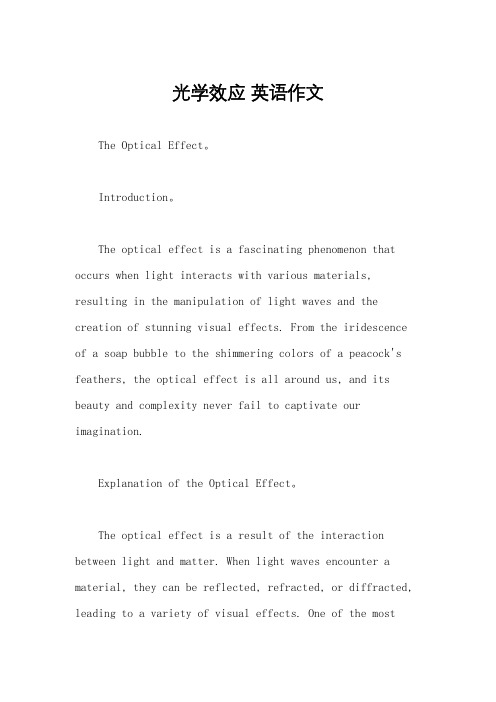
光学效应英语作文The Optical Effect。
Introduction。
The optical effect is a fascinating phenomenon that occurs when light interacts with various materials, resulting in the manipulation of light waves and the creation of stunning visual effects. From the iridescence of a soap bubble to the shimmering colors of a peacock's feathers, the optical effect is all around us, and its beauty and complexity never fail to captivate our imagination.Explanation of the Optical Effect。
The optical effect is a result of the interaction between light and matter. When light waves encounter a material, they can be reflected, refracted, or diffracted, leading to a variety of visual effects. One of the mostcommon optical effects is iridescence, which occurs whenlight waves are scattered by the microstructures on the surface of a material, creating a rainbow-like display of colors. Another well-known optical effect is the shimmering of a mirage, which is caused by the refraction of light asit passes through layers of air with different temperatures. Applications of the Optical Effect。
光学纯对映体 英文
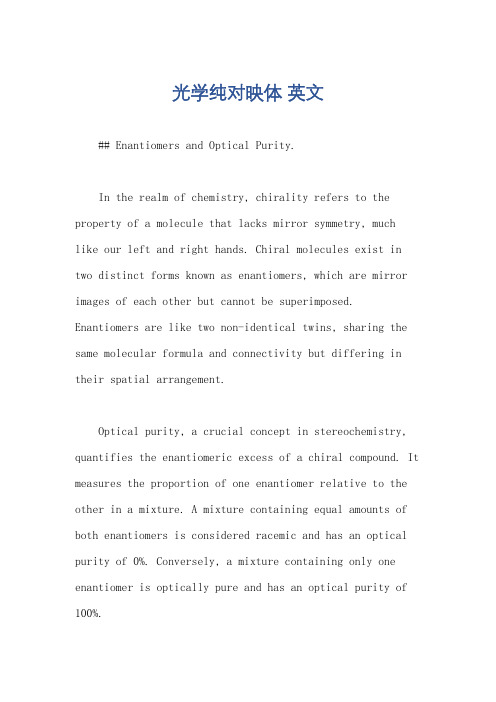
光学纯对映体英文## Enantiomers and Optical Purity.In the realm of chemistry, chirality refers to the property of a molecule that lacks mirror symmetry, muchlike our left and right hands. Chiral molecules exist in two distinct forms known as enantiomers, which are mirror images of each other but cannot be superimposed. Enantiomers are like two non-identical twins, sharing the same molecular formula and connectivity but differing in their spatial arrangement.Optical purity, a crucial concept in stereochemistry, quantifies the enantiomeric excess of a chiral compound. It measures the proportion of one enantiomer relative to the other in a mixture. A mixture containing equal amounts of both enantiomers is considered racemic and has an optical purity of 0%. Conversely, a mixture containing only one enantiomer is optically pure and has an optical purity of 100%.### Separation of Enantiomers.The separation of enantiomers is a challenging yet essential task in many fields, including pharmaceuticals, agrochemicals, and fragrances. Various techniques can be employed to achieve this, including:Chiral chromatography: This technique utilizes achiral stationary phase that interacts differently with different enantiomers, allowing for their separation.Chiral resolution: This involves converting a racemic mixture into a pair of diastereomers, which can then be separated by conventional methods.Enzymatic resolution: Enzymes, being chiral themselves, can selectively catalyze reactions with one enantiomer over the other, leading to the formation of optically pure products.### Optical Purity Measurement.Optical purity can be determined using various methods, such as:Polarimetry: This technique measures the rotation of plane-polarized light as it passes through a chiral sample. The magnitude and direction of rotation depend on the enantiomeric composition of the sample.NMR spectroscopy: Chiral solvents or chiral shift reagents can be used in NMR spectroscopy to differentiate between enantiomers based on their different chemical shifts.Chromatographic methods: Chiral chromatography or capillary electrophoresis can be used to separate enantiomers and determine their relative abundance.### Significance of Optical Purity.Optical purity is of paramount importance in several areas:Pharmacology: Many drugs are chiral, and their enantiomers can have different pharmacological properties, including efficacy, toxicity, and metabolism. Enantiopure drugs offer advantages in terms of safety and effectiveness.Agrochemicals: Herbicides and pesticides can be chiral, and their enantiomers may differ in their selectivity and environmental impact. Optical purity ensures the targeted control of pests and weeds.Fragrances and flavors: The fragrance and flavor of chiral compounds can depend on their enantiomeric composition. Optical purity control allows for the creation of specific scents and tastes.### Applications of Chiral Compounds.Chiral compounds find widespread applications invarious industries:Pharmaceuticals: Enantiopure drugs include ibuprofen,naproxen, and thalidomide.Agrochemicals: Herbicides such as glyphosate and pesticides like cypermethrin are chiral.Fragrances and flavors: Enantiopure compounds like menthol, camphor, and limonene contribute to thedistinctive scents and tastes of products.Materials science: Chiral polymers, liquid crystals, and self-assembling systems have unique properties and applications in optics, electronics, and nanotechnology.### Conclusion.The concept of enantiomers and optical purity is crucial for understanding the stereochemistry of chiral compounds. The ability to separate and determine the optical purity of enantiomers is essential in numerous fields, including pharmaceuticals, agrochemicals, and fragrances. The significance of optical purity lies in itsimplications for the safety, efficacy, and properties of chiral compounds in various applications.。
负折射率隐身衣英文版

Ran Duan,1 Elena Semouchkina,2,* and Ravi Pandey1
1Leabharlann Abstract: The geometric optics principles are used to develop a unidirectional transmission cloak for hiding objects with dimensions substantially exceeding the incident radiation wavelengths. Invisibility of both the object and the cloak is achieved without metamaterials, so that significant widths of the cloaking bands are provided. For the preservation of wave phases, the λ-multiple delays of waves passing through the cloak are realized. Suppression of reflection losses is achieved by using half-λ multiple thicknesses of optical elements. Due to periodicity of phase delay and reflection suppression conditions, the cloak demonstrates efficient multiband performance confirmed by full-wave simulations.
Optical Communications

Optical CommunicationsOptical communications refer to the transmission of information using light as the signal. It is a crucial technology that has revolutionized the way we communicate, particularly in the field of telecommunications. Optical communications have become the backbone of modern communication systems, and they have enabled the transmission of vast amounts of data over long distances. One of the primary requirements of optical communications is high bandwidth. The demand for high-speed data transmission has increased significantly in recent years due to the rise of cloud computing, big data, and the Internet of Things (IoT). Optical communications provide the necessary bandwidth to support these technologies, enabling data to be transmitted at high speeds over long distances. Another requirement of optical communications is low attenuation. Attenuation refers to the loss of signal strength as it travels through a medium. Optical fibers, which are used in optical communications, have low attenuation, which means that they can transmit signals over long distances without significant signal loss. This is essential for long-distance communication, such as transoceanic communication. Optical communications also require low noise. Noise refers to any unwanted signal that interferes with the desired signal. In optical communications, noise can come from various sources, including environmental factors, such as temperature changes and vibrations. To ensure high-quality signal transmission, optical communication systems must be designed to minimize noise. Another critical requirement of optical communications is reliability. Optical communication systems must be designed to operate reliably in harsh environments, such as extreme temperatures, high humidity, and electromagnetic interference. Reliability is particularly important in critical applications, such as inaviation and defense. Finally, optical communications require security. With the increasing amount of sensitive data being transmitted over optical communication systems, security has become a significant concern. Optical communication systems must be designed to prevent unauthorized access and ensure the confidentiality and integrity of transmitted data. In conclusion, optical communications are acrucial technology that has revolutionized the way we communicate. They provide high bandwidth, low attenuation, low noise, reliability, and security, making themideal for transmitting vast amounts of data over long distances. As the demand for high-speed data transmission continues to grow, optical communications will continue to play a critical role in modern communication systems.。
2018年全国声学大会在北京顺利召开
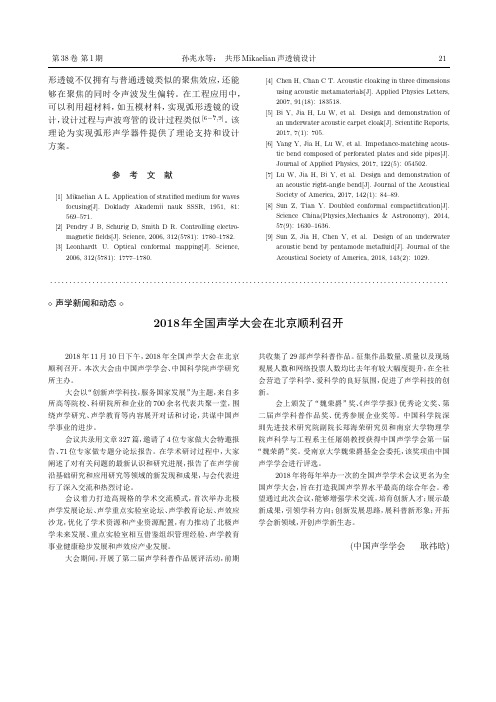
第38卷第1期孙兆永等:共形Mikaelian声透镜设计21形透镜不仅拥有与普通透镜类似的聚焦效应,还能够在聚焦的同时令声波发生偏转。
在工程应用中,可以利用超材料,如五模材料,实现弧形透镜的设计,设计过程与声波弯管的设计过程类似[6−7,9]。
该理论为实现弧形声学器件提供了理论支持和设计方案。
参考文献[1]Mikaelian A L.Application of stratified medium for wavesfocusing[J].Doklady Akademii nauk SSSR,1951,81:569–571.[2]Pendry J B,Schurig D,Smith D R.Controlling electro-magneticfields[J].Science,2006,312(5781):1780–1782.[3]Leonhardt U.Optical conformal mapping[J].Science,2006,312(5781):1777–1780.[4]Chen H,Chan C T.Acoustic cloaking in three dimensionsusing acoustic metamaterials[J].Applied Physics Letters, 2007,91(18):183518.[5]Bi Y,Jia H,Lu W,et al.Design and demonstration ofan underwater acoustic carpet cloak[J].Scientific Reports, 2017,7(1):705.[6]Yang Y,Jia H,Lu W,et al.Impedance-matching acous-tic bend composed of perforated plates and side pipes[J].Journal of Applied Physics,2017,122(5):054502.[7]Lu W,Jia H,Bi Y,et al.Design and demonstration ofan acoustic right-angle bend[J].Journal of the Acoustical Society of America,2017,142(1):84–89.[8]Sun Z,Tian Y.Doubled conformal compactification[J].Science China(Physics,Mechanics&Astronomy),2014, 57(9):1630–1636.[9]Sun Z,Jia H,Chen Y,et al.Design of an underwateracoustic bend by pentamode metafluid[J].Journal of the Acoustical Society of America,2018,143(2):1029.........................................................................................................⋄声学新闻和动态⋄2018年全国声学大会在北京顺利召开2018年11月10日下午,2018年全国声学大会在北京顺利召开。
Metamaterials and their applications
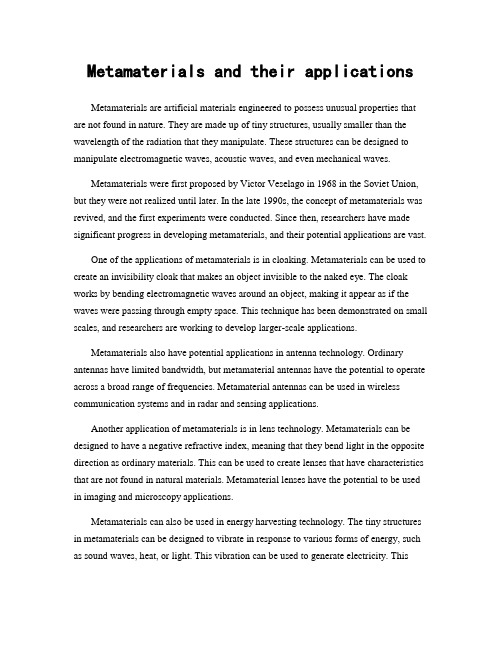
Metamaterials and their applicationsMetamaterials are artificial materials engineered to possess unusual properties that are not found in nature. They are made up of tiny structures, usually smaller than the wavelength of the radiation that they manipulate. These structures can be designed to manipulate electromagnetic waves, acoustic waves, and even mechanical waves.Metamaterials were first proposed by Victor Veselago in 1968 in the Soviet Union, but they were not realized until later. In the late 1990s, the concept of metamaterials was revived, and the first experiments were conducted. Since then, researchers have made significant progress in developing metamaterials, and their potential applications are vast.One of the applications of metamaterials is in cloaking. Metamaterials can be used to create an invisibility cloak that makes an object invisible to the naked eye. The cloak works by bending electromagnetic waves around an object, making it appear as if the waves were passing through empty space. This technique has been demonstrated on small scales, and researchers are working to develop larger-scale applications.Metamaterials also have potential applications in antenna technology. Ordinary antennas have limited bandwidth, but metamaterial antennas have the potential to operate across a broad range of frequencies. Metamaterial antennas can be used in wireless communication systems and in radar and sensing applications.Another application of metamaterials is in lens technology. Metamaterials can be designed to have a negative refractive index, meaning that they bend light in the opposite direction as ordinary materials. This can be used to create lenses that have characteristics that are not found in natural materials. Metamaterial lenses have the potential to be used in imaging and microscopy applications.Metamaterials can also be used in energy harvesting technology. The tiny structures in metamaterials can be designed to vibrate in response to various forms of energy, such as sound waves, heat, or light. This vibration can be used to generate electricity. Thistechnology has the potential to be used in sensors and other devices that require low levels of power.In addition to the applications mentioned above, metamaterials are also being explored for use in other areas, such as superlenses, which can theoretically be used to create images with higher resolution than is possible with natural lenses, and acoustic cloaks, which can be used to make objects invisible to sound waves.Despite their potential applications, metamaterials still face significant challenges. One of the biggest challenges is scalability. Currently, most experiments involving metamaterials are conducted on small scales, and it is difficult to create large-scale materials that have the desired properties. Another challenge is the cost of producing metamaterials. They are currently expensive to produce, which limits their practical applications.In conclusion, metamaterials are a promising area of research with many potential applications. They have the potential to transform a wide range of technologies and have already demonstrated significant breakthroughs in the fields of imaging, energy harvesting, communication, and cloaking. Although there are still challenges to be overcome, the progress made in this field provides hope for future technological advancements.。
optical materials文章
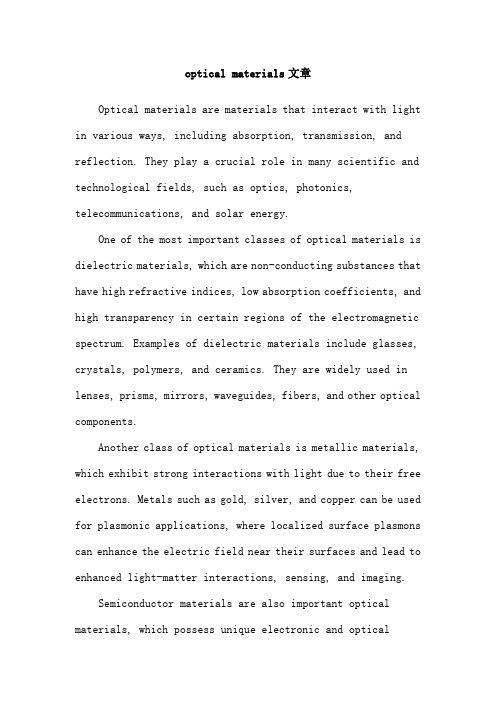
optical materials文章Optical materials are materials that interact with light in various ways, including absorption, transmission, and reflection. They play a crucial role in many scientific and technological fields, such as optics, photonics, telecommunications, and solar energy.One of the most important classes of optical materials is dielectric materials, which are non-conducting substances that have high refractive indices, low absorption coefficients, and high transparency in certain regions of the electromagnetic spectrum. Examples of dielectric materials include glasses, crystals, polymers, and ceramics. They are widely used in lenses, prisms, mirrors, waveguides, fibers, and other optical components.Another class of optical materials is metallic materials, which exhibit strong interactions with light due to their free electrons. Metals such as gold, silver, and copper can be used for plasmonic applications, where localized surface plasmons can enhance the electric field near their surfaces and lead to enhanced light-matter interactions, sensing, and imaging.Semiconductor materials are also important optical materials, which possess unique electronic and opticalproperties due to their band structure. They are widely used in optoelectronics and photovoltaics, where they can absorb, emit, and manipulate light with high efficiency. Silicon, gallium arsenide, and indium phosphide are some examples of semiconductor materials.In recent years, there has been increasing interest in novel optical materials, such as metamaterials, photonic crystals, and 2D materials. These materials exhibit exotic optical properties that do not exist in natural materials, and hold great promise for advanced optical applications, such as cloaking, superlensing, and quantum optics.Overall, optical materials continue to attract significant attention from researchers and engineers due to their fundamental importance and wide range of applications in modern technology.。
隐身衣的作文400字

隐身衣的作文400字英文回答:In the realm of scientific advancements, the quest for invisibility has captivated the imagination of researchers and science fiction enthusiasts alike. While the concept of an invisibility cloak may seem like a futuristic dream, significant strides have been made towards developing materials with the ability to manipulate light and render objects invisible.One promising approach involves the use of metamaterials, which are engineered materials with unusual optical properties. By carefully structuring these materials at a nanoscale, researchers can create devices that control the way light interacts with an object, bending and redirecting it around the object as if it were not there. This technique, known as cloaking, has been demonstrated in laboratory settings, making objects invisible to certain wavelengths of light.Another approach to invisibility focuses on manipulating the refractive index of a material. The refractive index determines how light bends when passing through a substance. By carefully tuning the refractive index of a material to match that of its surroundings, itis possible to create the illusion of transparency. This technique, known as refractive index matching, has been used to develop transparent materials that are virtually indistinguishable from their surroundings, effectively rendering them invisible.While these technologies hold great promise, they still face significant challenges before they can be applied to practical applications. Metamaterials, for example, are often bulky and difficult to manufacture, limiting their use in real-world scenarios. Refractive index matching, on the other hand, is only effective for specific wavelengths of light, making it unsuitable for achieving broadband invisibility.Despite these challenges, the pursuit of invisibilitycontinues to drive scientific research forward. Asscientists overcome these obstacles and refine existing technologies, it is possible that the dream of aninvisibility cloak may one day become a reality.中文回答:隐身衣,作为科幻小说中常见的概念,一直是科学研究梦寐以求的目标。
光电材料英语
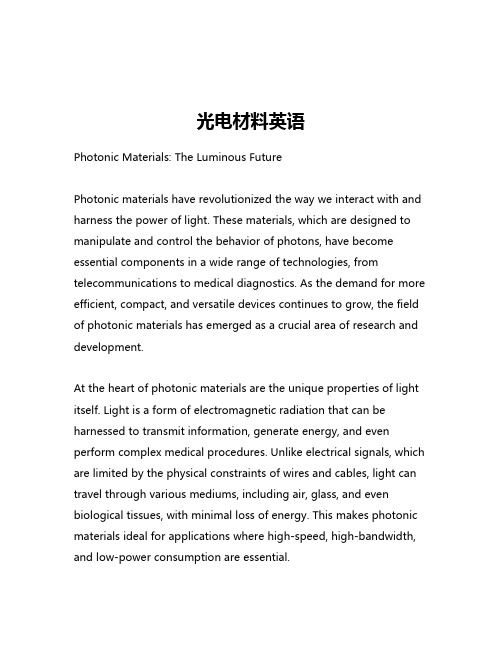
光电材料英语Photonic Materials: The Luminous FuturePhotonic materials have revolutionized the way we interact with and harness the power of light. These materials, which are designed to manipulate and control the behavior of photons, have become essential components in a wide range of technologies, from telecommunications to medical diagnostics. As the demand for more efficient, compact, and versatile devices continues to grow, the field of photonic materials has emerged as a crucial area of research and development.At the heart of photonic materials are the unique properties of light itself. Light is a form of electromagnetic radiation that can be harnessed to transmit information, generate energy, and even perform complex medical procedures. Unlike electrical signals, which are limited by the physical constraints of wires and cables, light can travel through various mediums, including air, glass, and even biological tissues, with minimal loss of energy. This makes photonic materials ideal for applications where high-speed, high-bandwidth, and low-power consumption are essential.One of the most significant advancements in photonic materials has been the development of semiconductor-based devices. Semiconductors, such as silicon and gallium arsenide, can be engineered to absorb, emit, or manipulate light in specific ways, enabling the creation of a wide range of photonic components, including lasers, photodetectors, and light-emitting diodes (LEDs). These components are the building blocks of many modern technologies, from fiber-optic communication networks to high-definition displays.Beyond semiconductors, photonic materials also encompass a diverse array of other materials, each with its own unique properties and applications. For example, optical fibers, which are made of thin strands of glass or plastic, can be used to transmit data over long distances with minimal signal loss. Photonic crystals, which are materials with a periodic structure that can control the flow of light, have been used to develop highly efficient light-emitting devices and optical sensors.Another exciting area of photonic materials research is the development of metamaterials. Metamaterials are engineered materials that can manipulate the behavior of light in ways that are not found in nature. These materials, which are often constructed from arrays of tiny, precisely engineered structures, can be used to create lenses that can focus light beyond the diffraction limit, or todevelop cloaking devices that can render objects invisible to certain wavelengths of light.The applications of photonic materials are vast and varied. In the field of telecommunications, photonic materials have enabled the development of high-speed, high-capacity fiber-optic networks that can transmit vast amounts of data over long distances. In the medical field, photonic materials have been used to create advanced imaging technologies, such as optical coherence tomography (OCT), which can provide detailed, three-dimensional images of the human body without the need for invasive procedures.In the field of energy, photonic materials are playing a crucial role in the development of more efficient and sustainable energy technologies. For example, photovoltaic cells, which convert light into electrical energy, rely on photonic materials to absorb and convert light with high efficiency. Similarly, photonic materials are being used to develop advanced lighting technologies, such as LEDs, which are more energy-efficient and longer-lasting than traditional incandescent bulbs.As the field of photonic materials continues to evolve, the potential applications of these materials are only limited by our imagination. From advancements in telecommunications and medical diagnostics to the development of more efficient and sustainable energytechnologies, photonic materials are poised to play a crucial role in shaping the future of our world.。
Plasmonics and metamaterials for photonics
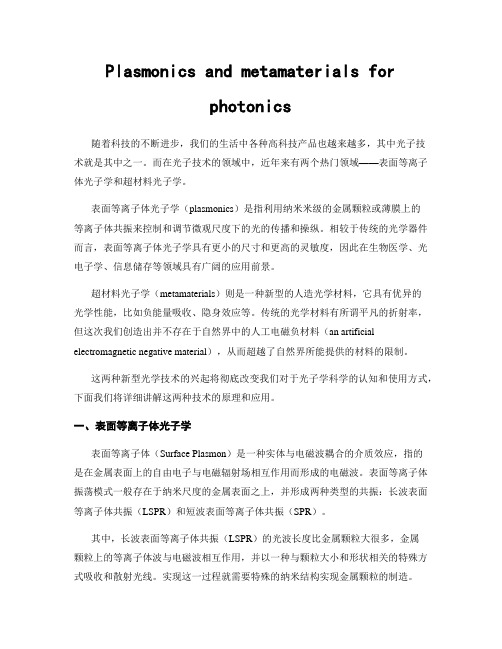
Plasmonics and metamaterials forphotonics随着科技的不断进步,我们的生活中各种高科技产品也越来越多,其中光子技术就是其中之一。
而在光子技术的领域中,近年来有两个热门领域——表面等离子体光子学和超材料光子学。
表面等离子体光子学(plasmonics)是指利用纳米米级的金属颗粒或薄膜上的等离子体共振来控制和调节微观尺度下的光的传播和操纵。
相较于传统的光学器件而言,表面等离子体光子学具有更小的尺寸和更高的灵敏度,因此在生物医学、光电子学、信息储存等领域具有广阔的应用前景。
超材料光子学(metamaterials)则是一种新型的人造光学材料,它具有优异的光学性能,比如负能量吸收、隐身效应等。
传统的光学材料有所谓平凡的折射率,但这次我们创造出并不存在于自然界中的人工电磁负材料(an artificial electromagnetic negative material),从而超越了自然界所能提供的材料的限制。
这两种新型光学技术的兴起将彻底改变我们对于光子学科学的认知和使用方式,下面我们将详细讲解这两种技术的原理和应用。
一、表面等离子体光子学表面等离子体(Surface Plasmon)是一种实体与电磁波耦合的介质效应,指的是在金属表面上的自由电子与电磁辐射场相互作用而形成的电磁波。
表面等离子体振荡模式一般存在于纳米尺度的金属表面之上,并形成两种类型的共振:长波表面等离子体共振(LSPR)和短波表面等离子体共振(SPR)。
其中,长波表面等离子体共振(LSPR)的光波长度比金属颗粒大很多,金属颗粒上的等离子体波与电磁波相互作用,并以一种与颗粒大小和形状相关的特殊方式吸收和散射光线。
实现这一过程就需要特殊的纳米结构实现金属颗粒的制造。
在生物医学方面,LSPR技术被广泛应用于光学探针和光声成像等领域。
表面等离子体共振(SPR)成像技术则能检测生物分子静态或动态吸附到金属表面上的变化,其精度已经超过传统生物检测技术。
可见光透射近红外反射 超材料

可见光透射近红外反射超材料超材料是一种具有特异结构的材料,它可以通过改变电磁场来引导、调节和控制光波的传输,使其产生多种奇特的光学效应。
在近年来的研究中,加入超材料在可见光透射近红外反射方面的应用得到了越来越多的重视。
本文将探讨超材料在可见光透射近红外反射方面的应用以及相关参考内容。
超材料的特点超材料是一种人工制造的亚波长周期结构材料,其微观结构中包含子波长特征,通常采用纳米结构设计。
超材料的特点在于,其折射率和材料本身的折射率不同,导致入射光可以被引导、反射、折射,以及在材料中的散射等。
这些过程的结果将引起多种光学现象,如负折射、超透镜、折射率、反射率和透射率的调节、偏振与色散控制等等。
由于这些奇特的现象,超材料在可见光透射近红外反射领域有着广泛的应用前景。
超材料在可见光透射方面的应用超材料在可见光透射方面主要应用于防伪和光学显示领域。
在这些应用中,超材料可以改变入射光的颜色或方向,从而使其具有更多的视觉效果和防伪功能。
最常见的应用是光学显示器。
通过使用超材料制作光学显示器,可以使光学显示器更加清晰和亮度更高。
此外,超材料还可以使检测光通过屏幕而不是被反射,从而减少亮度和反光。
超材料在可见光透射方面的应用还包括防伪技术。
超材料可以通过所涂抹的颜料控制可见光的颜色来识别伪造品。
负折射的原理使得超材料可以增加反射率,并且可以在某个颜色和光亮级别之间具有特定反射率。
超材料在近红外反射方面的应用超材料在近红外反射方面的应用是指它可以控制光在近红外波段的反射特性。
在医疗器械和军事领域中,使用近红外光可以提高成像系统的准确性和分辨率,以及探测隐藏的物质。
超材料增强了能够反射的光谱,从而能够提高近红外成像铝。
超材料的作用还涉及到生物医疗领域。
使用超材料可以减少并缩短光传输路径,提高单光子发射的信噪比,实现高灵敏量子操控。
此外,超材料可以在高分辨率功能中发挥重要作用,如在生物成像和药物传递方面。
相关参考内容1. R. A. Shelby, D. R. Smith, and S. Schultz, "Experimental verification of a negative index of refraction," Science 292, 77-79 (2001).这项研究为第一次实验验证了材料具有负折射率的概念,并首次展示了能够通过不同的光学结构来控制材料的折射率。
任意形状声学黑洞的简化设计方法

任意形状声学黑洞的简化设计方法许卫锴;张蒙;王伟【摘要】提出一种简化的任意形状声学黑洞设计方法.利用比例映射变换,可以消除传统声学变换方法所导致的材料参数的高度各向异性,降低声学黑洞吸收体的制作成本.数值结果表明,该模型可以实现复杂形状下声波的显著吸收,证明了任意形状声学黑洞的有效性.该工作将对声学能量吸收和噪声控制提供一定的理论依据.【期刊名称】《沈阳航空航天大学学报》【年(卷),期】2017(034)006【总页数】5页(P22-26)【关键词】声学黑洞;任意形状;比例映射;声学变换【作者】许卫锴;张蒙;王伟【作者单位】沈阳航空航天大学航空航天工程学部(院),沈阳110136;沈阳航空航天大学航空航天工程学部(院),沈阳110136;沈阳建筑大学土木工程学院,沈阳110168【正文语种】中文【中图分类】O429;TB535波的吸收问题一直以来都是人们研究的重点,并在多个学科都得到了广泛地关注,如光学、微波、声学、热学等领域。
由于其惊人的吞噬能力,很多学者用“黑洞”的概念来形容完美的吸收体,并进行了广泛的研究。
然而对于传统的黑洞设计来说,无论是吸波材料或是吸波结构都存在着各自的局限性,或者受限于特殊的入射角度[1-2],或者只具有非常窄的带宽[3]。
因此,研究宽频带、高吸收的黑洞结构成为一个重要的课题。
近年来,一种基于“有效势(Effective potential)”概念的黑洞结构得到了研究人员的关注。
通过合理设计材料的参数分布,可以实现折射率随位置变化的函数式分布[4],从而形成类似于势力场的空间,最终达到控制波的传播路径的目的。
第一个光学黑洞由Narimanov等人提出[5],并很快得到了实验验证[6-8]。
而利用光波与声波方程的相似性,与光学黑洞类似的声学黑洞也得到了关注,并由理论证实[9]和实验验证[10]。
随后,声学黑洞得到了大量的研究,例如Song等人利用超材料实现声相干完美吸收器[11],Naify[12]和Elliott[13]利用梯度材料设计了全方位的水下完美吸收体,Cheng等人利用均匀的各向异性超材料设计了一个二维宽频带的全方位声学吸收体并完成实验验证[14],Hu等人则利用坐标变换方法设计了弹性波的黑洞结构[15]。
- 1、下载文档前请自行甄别文档内容的完整性,平台不提供额外的编辑、内容补充、找答案等附加服务。
- 2、"仅部分预览"的文档,不可在线预览部分如存在完整性等问题,可反馈申请退款(可完整预览的文档不适用该条件!)。
- 3、如文档侵犯您的权益,请联系客服反馈,我们会尽快为您处理(人工客服工作时间:9:00-18:30)。
F. Bilotti, S. Tricarico, and L. Vegni Department of Applied Electronics – University “Roma Tre” Via della Vasca Navale, 84 – 00146 – Rome – ITALY e-mail: vegni@uniroma3.it Summary In this contribution, we present the design of cylindrical electromagnetic cloaks working at optical frequencies, making use of layered structures of plasmonic and non-plasmonic materials. The simulated results confirm the validity of the proposed approach and show a rather broad-band behavior of the cloaking device. Introduction Different approaches to design electromagnetic cloaking devices have been proposed in the last few years by some groups worldwide [1]-[7]. Each of them is characterized by advantages and drawbacks. The approach proposed in [4]-[5] has some undoubted advantages in terms of the bandwidth of operation and the relatively simple nature of the material cover used to cloak a given object. In that case, in fact, the cover materials are homogeneous and characterized by a close-to-zero real part of the permittivity. This is an important advantage over, for instance, the method proposed in [1]-[3], which is based, instead, on the employment of inhomogeneous material cloaks with a certain profile of the constitutive parameters. Even if the approach presented in [4]-[5] makes use of homogenous materials, the design of proper materials exhibiting the required values of permittivity is, anyway, a difficult task. In the microwave frequency range, a simple design of a cylindrical cloak has been recently proposed in [5]. The material with a close-to-zero real permittivity has been implemented in that case through a proper generalization of the parallel plate medium approach. Anyway, if we would like to extend the cloaking approach proposed in [4]-[5] to the visible regime, we run in troubles. On one hand, in fact, the parallel plate medium cannot be used anymore, and, on the other hand, there is a lack of useful natural materials. As previously anticipated, in fact, useful materials are characterized by a close-to-zero real permittivity, which means that the plasma frequency should rest in the visible. Unfortunately, noble metals, such as gold and silver, have plasma frequencies at smaller wavelengths in the ultra-violet regime and, thus, exhibit a strong plasmonic (i.e. the real permittivity is negative) behavior in the visible. For this reason, they are not useful as such. In this contribution, we propose a way to extend the approach presented in [4]-[5] to the optical frequency range, through the employment of proper layered structures made of plasmonic and non-plasmonic materials. The same method can be straightforwardly applied also to obtain cloaking devices in the IR regime. Formulation and design In order to synthesize a material with the plasma frequency laying in the visible, we may use the approach proposed for a different purpose and for a planar configuration in [8]. By stacking two different material slabs, if the thicknesses of the slabs are electrically small, in [8] it is shown that the resulting composite material is described through constitutive parameters depending only on the ratio between the thicknesses of the two slabs and the constitutive parameters of the two different materials.
References [1] J. B. Pendry, D. Schurig, D.R. Smith, Science, 312, 1780 (2006) [2] U. Leonhardt, Science, 312, 1777 (2006) [3] W. Cai, U. Chettiar, A. Kildishev, V. Shalaev, Nature Photonics 1, 224 (2007) [4] A. Alu, N. Engheta, Phys. Rev. E, 72, 016623 (2005) [5] M.G. Silveirinha, A. Alù, N. Engheta, Physical Review E, 75, 036603 (2007) [6] N.A. Nicorovici, G.W. Milton, R.C. McPhedran, L.C. Botten, Optics Express, 15, 6314 (2007) [7] P. Alitalo, O. Luukkonen, L. Jylhä, J. Venermo, S.A. Tretyakov, IEEE Trans. Antennas Propagat., 56, 416 (2008) [8] B. Wood, J.B. Pendry, D.P. Tsai, Phys. Rev. B, 74, 115116 (2006)
d2 d1
Fig. 1
(left) Cylindrical cloak made of concentric shells of different materials. (right) Cylindrical cloak made of stacked disks of different materials.
If the two materials are a plasmonic material like silver (Ag) and regular silica (SiO2), it is possible to obtain in both configurations a close-to-zero real permittivity along the axis of the cylinder in the IR and visible regimes. Therefore, we can now apply the formulation in [4]-[5] to reduce the total scattering cross section of the covered cylindrical object in order to design the cloak. In Fig. 2 we show the full-wave simulated results obtained in the case of a finite cylindrical object. The reduction of the total scattering cross-section is well evident.
